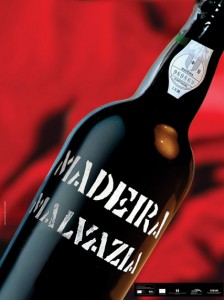OK, yes, I wrote about desert island wines previously, but what if you were truly stranded on a desert island? You certainly wouldn’t have temperature-controlled wine storage available to you and eventually your wines would spoil in the heat. But what about a wine that was designed to withstand the heat and would even continue to improve on the voyage to said desert island? Madeira — a wine created to survive the long sea voyage from Europe to the New World– would be the perfect wine for such circumstances.
Madeira is a volcanic island off the coast of Portugal and is the home of Madeira wine. Here, Tinta Negra Mole, Sercial, Verdelho, Bual and Malmsey (aka Malvasia) are grown on the steep slopes of the island. All, but the Tinta Negra, are white grape varieties. The wine itself owes its taste and character to its fortification (through the addition of a neutral grape-based spirit similar to Port or Sherry) and its prolonged exposure to the heat. The fortification interrupts the fermentation process and, depending upon when it occurs, generally prevents some of the sugar from being converted into alcohol, thereby creating a wine with some sweetness.
Four styles of wine — dry, semi-dry, semi-sweet and sweet — are produced, corresponding to the grape variety used. Sercial is the driest style, followed by Verdelho and Bual, with Malmsey being the sweetest. However, despite being labeled as “sweet”, these wines are drier than you might think and can actually pair nicely with savory foods, such as cheeses, wild game and nuts, as well as, if not better than, desserts.
After the fortification, the wine is subjected to high temperatures in either a heated, concrete vat (an estufa) for several months or through prolonged storage in oak casks in naturally warm rooms (canteiros) over several years, recreating the conditions found when the wine was shipped over lengthy distances. Given the slow and steady process, the Canteiro method is considered to be of higher quality and thus generally reserved for the Sercial, Verdelho, Bual and Malmsey grapes, while Tinta Negra Mole are most often heated in Estufagem. A minimum of 85% of the grapes must be from the named grape variety if it is stated on the label.
With its ability to withstand the heat, Madeira would do well in the sans-refrigerator environment of the desert island. For those of us on Manhattan island (hot right now, but fortunately, not under desert conditions) as well as elsewhere in the United States, Madeira is a perfect wine to enjoy now. And, as some of my colleague, Rebecca Chapa, has pointed out, it is timely too, as George Washington toasted the first Independence Day back in 1776 with a glass of Madeira.
A June tasting, sponsored by the Madeira Wine, Embroidery and Handcraft Institute (IVBAM), showcased some of the top Madeira producers, including Blandy’s, Broadbent, Henriques & Henriques, Justino’s, Pereira d’Oliveira and Vinhos Barbeito. Here are a few tasting notes from that event:
Henriques & Henriques 10 Years Old Verdelho, Portugal
Dating back to 1850, Henriques & Henriques is the largest independent producer and shipper of Madeira. Medium mahoghany in color with aromas of honey, burnt orange and oxidation, this wine is off-dry with rich flavors of orange peel, honey and raisin that linger in its long length.
Vinhos Berbeito Historic Series Malmsey New York Special Reserve, Portugal
Established in 1946 by Mario Barbeito, this Madeira producer has a shorter history than many other firms, but has created an historic series based on the styles of wine preferred by various colonial cities. Colonial New Yorkers preferred a richer style of wine compared to their colleagues in Charleston and Savannah, with coffee, toffee and raisin notes on the nose and medium-sweet palate, culminating in long length.
Broadbent Madeira Malmsey 10 Years Old, Portugal
Bartholemew Broadbent imports Madeira wines under his own label. This sweet wine has aromas of burnt sugar, oxidation and dried oranges, with flavors of spice, dried fruits and dried herbs on the palate.
D’Oliveira Reserve Sercial 1969, Portugal
A small producer, Pereira d’Oliveira is known for its large stocks of old and rare wines. This older vintage is still showing some color with notes of burnt sugar and honey. It is dry with oxidized notes, honey and spice on the palate.
Blandy’s Madeira Vintage Bual 1968, Portugal
Blandy’s was named for a soldier who landed on Madeira in 1808 and eventually settled on the island as a general trader in 1811. This vintage wine is pale in color, but still shows hues of mahoghany. The nose is rich and deep with notes of caramel and burnt sugar. On the palate, it is medium-sweet, with a hint of oxidation, caramel, burnt orange and treacle flavors that persist.


Hi Tracy
Wonderful article on Madeira, many thanks. I’m glad you loved our Broadbent 10 year Malmsey. It is yummy for sure! Just one point of clarification… we were sharing a table with Justino’s at the tasting but we don’t actually import their wines. It was great meeting you.
Bartholomew
Hi Bartholomew,
Thank you for the clarification and sorry for the misunderstanding. I’ve edited the article to reflect the correct information.
Great to have met you, too.
Best wishes,
Tracy